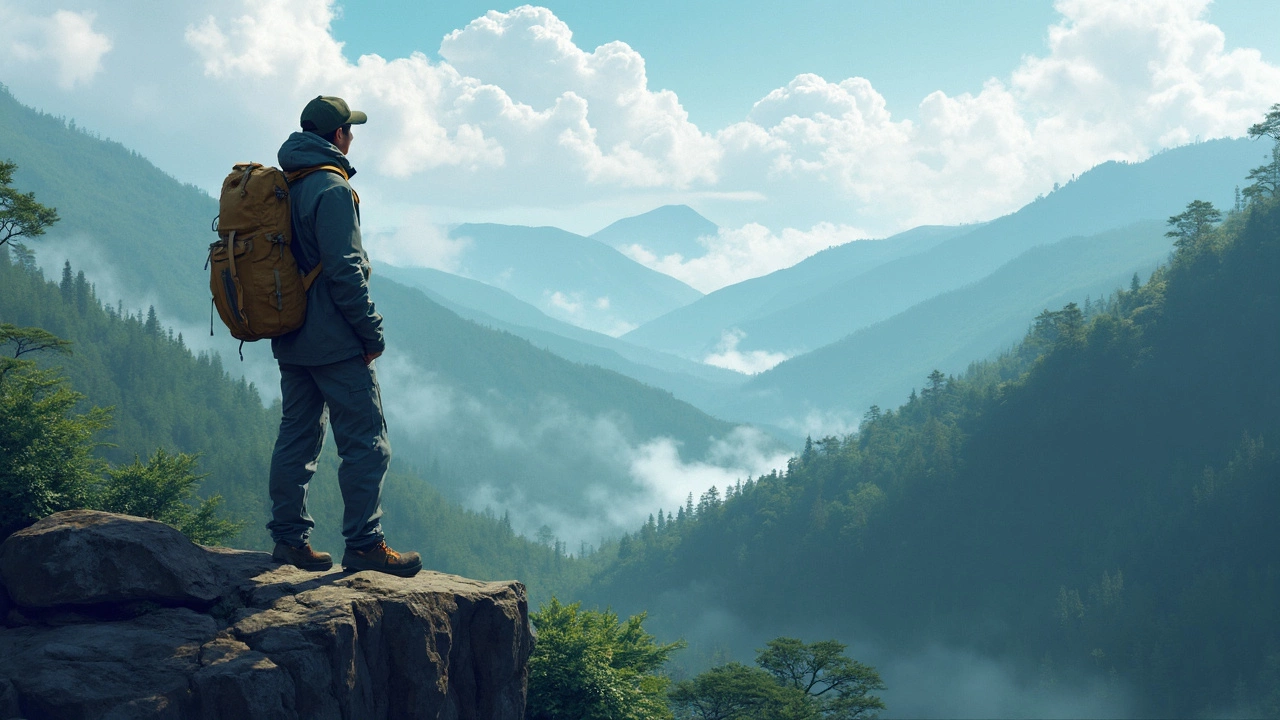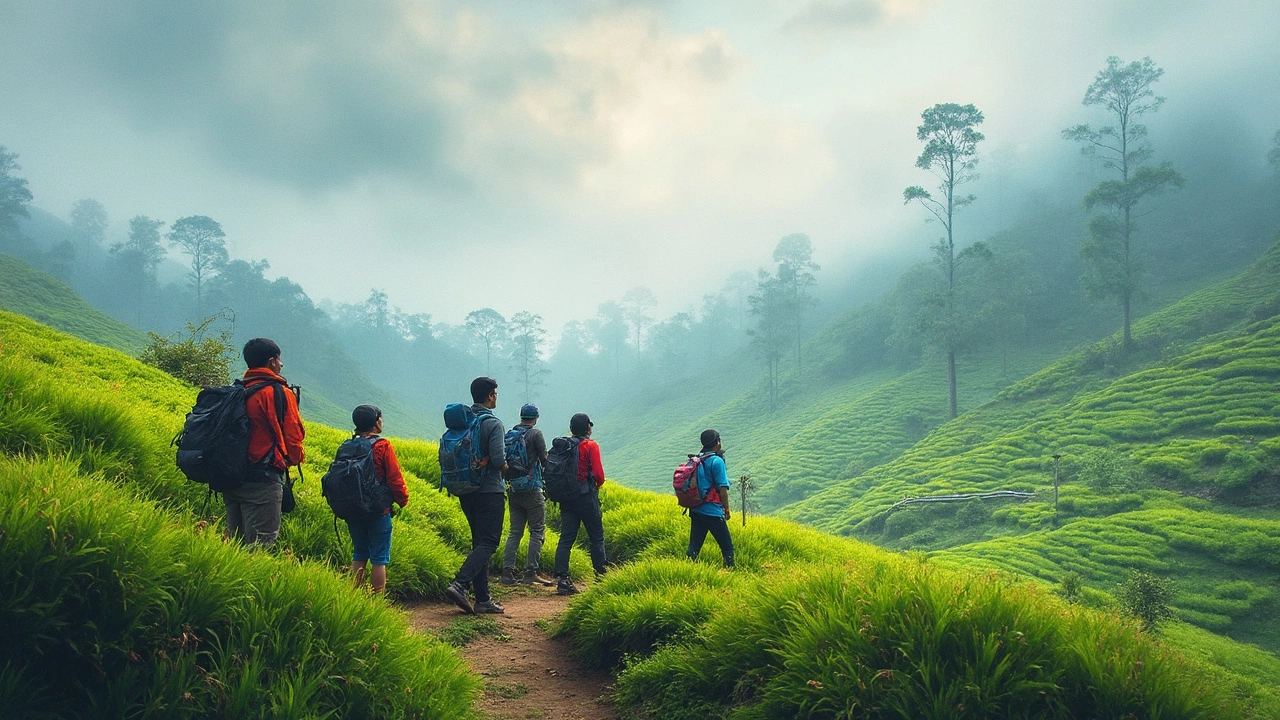Mastering the 3 Layer Rule for Hiking in India
 Apr, 8 2025
Apr, 8 2025
So, you're all set to explore the majestic trails of India, huh? Before you dive into those stunning landscapes, there's something you gotta get right—your clothing layers. Ever heard of the 3 layer rule for hiking? It's a simple but genius way to keep yourself comfortable, no matter if it's blazing hot, chilly, or pouring rain. Weather can be pretty unpredictable out there, especially in the hills and forests of India.
The 3 layer approach starts with your base layer, which acts like your second skin. This layer's job is to wick away sweat and keep you dry. You'll want something breathable, like merino wool or synthetic materials, to keep the moisture at bay. Trust me, no one likes that sticky feeling when you're trying to enjoy a scenic view.
Next up is the mid layer, providing insulation. Think of it as your personal thermostat—it traps heat to keep you warm when those mountain breezes start biting. Fleece jackets or lightweight down options are great picks here. You'll be thankful for this layer when the sun starts setting and the temperature drops.
- What is the 3 Layer Rule?
- Base Layer: Your Second Skin
- Mid Layer: The Insulation
- Outer Layer: Battling the Elements
- Applying the Rule to Indian Trekking Spots
What is the 3 Layer Rule?
The 3 layer rule is a smart and straightforward strategy to dress right for outdoor activities. It’s like having a cheat sheet for dealing with unpredictable weather that can flip from blazing hot to chilly or rainy in a blink, especially in India’s diverse trekking areas.
This method is designed to make you adaptable. Each layer has a specific function, and together they ensure you're well-equipped for whatever nature throws your way. Let’s break it down:
- Base Layer: This is your first line of defense, directly in contact with your skin. It wicks sweat away, keeping you dry. Ever tried hiking in a wet t-shirt? Not fun. Materials like merino wool or synthetics work wonders here.
- Mid Layer: Think of this layer as your heat trap. It helps insulate your body, maintaining the warmth, especially at higher altitudes. Fleece or down jackets usually do the trick.
- Outer Layer: This is your shield against the elements like wind, rain, and snow. A good outer layer is waterproof and windproof yet breathable enough to prevent you from feeling like you’re in a sauna.
This approach is not just effective but also super practical. It lets you mix and match layers based on the day’s forecast. Why carry a suitcase full of clothes when you can just layer up or down as needed?
Here’s a quick illustration of why it works: Imagine you're trekking in the Himalayas. The morning starts cool (hello base and mid-layers), the afternoon sun blasts down (strip down to your base), then it starts to rain unexpectedly (on with the outer layer). This flexibility is what makes the 3 layer rule a must-know for any hiker gearing up for an Indian trek.
Base Layer: Your Second Skin
Alright, let's talk about the first step in nailing the 3 layer rule for hiking—your base layer. Ever wondered why it's called your 'second skin'? This layer is all about keeping your body dry by wicking away sweat. Moisture is no hiker's friend since it can lead to chills, especially when the temperature drops. So, the base layer is like your best buddy in avoiding that uncomfortable, clammy feeling.
When picking your base layer, think about fabrics that excel in moisture management. Merino wool and synthetic materials like polyester are top choices. Why? They're breathable and quick-drying. Plus, merino wool has this cool feature of being naturally odor-resistant, which is awesome for those multi-day treks. You don't want to smell like yesterday's campfire the whole trip, right?
- Merino Wool: Soft, breathable, and perfect for temperature regulation. It's pricier, but totally worth it for comfort.
- Synthetic Fabrics: Affordable, durable, and great for moving sweat away fast. They're a bit less comfy than wool but dry quicker.
And here's a little secret from fellow hikers—make sure your base layer fits snug, like a gentle hug. Too loose, and it doesn't effectively wick sweat. Too tight, and you'll feel like a sausage. Strike that balance, and you'll thank yourself while tackling those beautiful Indian trails.
You might also wonder about the sleeves. Long sleeves protect against both the chill and sunburn, especially helpful in high-elevation areas where the sun can be surprisingly harsh. Short sleeves can work too, but consider sunscreen if you're going that route.
Keeping this in mind, your base layer becomes more than just clothing. It’s your invisible shield against the elements, setting the tone for a comfy trek. And that, my friend, is how you start mastering the 3 layer rule for unforgettable outdoor adventures!

Mid Layer: The Insulation
The mid layer is the unsung hero of your hiking gear. It's like having a portable micro-climate wrapped around you, keeping you snug and toasty when it's cold. When you're out tackling India's diverse trekking spots, this layer becomes super crucial. Why? Because the air temperature can swing wildly as you move from sunny trails to cool, shaded valleys.
Let's break it down. The main job of the mid layer is to trap body heat while still allowing enough breathability to let moisture escape. Imagine hiking up to the snowy reaches of the Himalayas—without proper insulation, you're gonna feel that chill right in your bones. But with the right mid layer, you're ready to enjoy the view without shivering.
Fleece jackets are a popular choice for tackling Indian trails. They're lightweight, durable, and do an amazing job at keeping you warm without overheating. If you're facing seriously cold conditions or a windy day, you might want to consider a thin down jacket. These are also packable, so they don't hog your backpack space. It's all about finding what suits your trip and your heat tolerance.
Here's a thing about fleece: it’s breathable, so it lets sweat escape, keeping you dry. But it doesn’t block wind that well, so layer up smartly with an outer shell when the winds pick up. Some trekkers even opt for a synthetic insulated jacket, which balances warmth and weight nicely, perfect for those longer hikes where you're unsure about the weather.
Check this out: while hiking in India, actual temperatures during trekking can vary widely, from comfortable 20 °C in regions like Kerala to freezing -10 °C in Ladakh. So, adjust your mid layer accordingly. Over time, you’ll figure out if you need one thick fleece or maybe a combination of thinner layers for flexibility.
Remember, layering is all about adjusting as you go. As you start steep climbs, unzipping your mid layer helps regulate temperature. The idea here isn’t to stay just warm, but to maintain that sweet spot where you’re light on sweat but shielded from the icy chill. Whatever you choose, a good mid layer is your close companion on any trekking adventure in India.
Outer Layer: Battling the Elements
Alright, here's where the magic really happens—your outer layer is your shield against whatever Mother Nature decides to throw your way. Whether that's wind, rain, or even snow, this layer's mission is to protect. Think of it as your personal force field. This is crucial when you're hiking in places like the Indian Himalayas or the Western Ghats.
The key features you want in your outer layer? Water resistance and breathability. A good rain jacket made from materials like Gore-Tex or a similar waterproof fabric is perfect. You want to stay dry but not feel like you're trapped in a plastic bag, right? Breathability ensures any moisture from your body can escape, preventing that clammy feeling.
Now, let's talk details. Look for jackets with sealed seams and adjustable hoods. These help keep the rain out and your head dry, which is a lifesaver during those sudden showers common in the Indian monsoon season. Vents under the arms are a bonus—they allow for extra breathability when you're working up a sweat on a steep climb.
Here's a quick checklist:
- Waterproof and breathable material
- Sealed seams
- Adjustable hood
- Pit zips for ventilation
- Packs easy—because saving space in your backpack matters!
When selecting your outer layer, consider the specific hiking gear you need for the trek you're planning. In snowier areas, you might want something with more insulation. Meanwhile, a lightweight packable shell is perfect for warm climates with occasional rain.
Don't underestimate the power of this layer. It's not just about staying dry—it's about staying comfortable and focused on the incredible sights around you.

Applying the Rule to Indian Trekking Spots
India offers incredible trekking spots from the snow-laden Himalayas to the lush Western Ghats. Each presents its own set of weather challenges, and that's where the 3 layer rule really shines. Let’s break down how you can nail this layering technique on India's diverse trails.
Starting with the base layer, when you're trekking through humid regions like Kerala's Meesapulimala, you need something light and sweat-wicking. A synthetic t-shirt works wonders here, ensuring your trek doesn’t feel like a sauna. Heading to cooler spots like Manali or Leh? Opt for a merino wool base as it keeps you warm without overheating.
The mid layer becomes crucial in regions with abrupt climate changes. In places like Ladakh, you can face warm sun and chilly winds all in one day. A fleece jacket can handle these shifts, keeping warmth in without bulk. If you're tackling high-altitude treks in the Himalayas, consider a lightweight down jacket for those cold evenings.
The outer layer is your shield. In trekking spots like Sikkim or the monsoon-laden hills of the Western Ghats, you'll want a waterproof and windproof jacket. These areas are known for sudden rain showers, so keeping dry is essential. Look for gear that’s not bulky so you can move freely, like a jacket made from Gore-Tex fabric.
Here's a quick look at how different trekking spots can demand varied approaches:
| Trekking Spot | Unique Requirement | Recommended Layers |
|---|---|---|
| Sikkim | Sudden Rainfall | Base - Synthetic, Mid - Fleece, Outer - Waterproof |
| Kedarkantha, Uttarakhand | Cold Nights | Base - Merino Wool, Mid - Down Jacket, Outer - Windproof |
| Western Ghats | Humid Climate | Base - Moisture-Wicking, Mid - Light Fleece, Outer - Breathable Waterproof |
By mastering this layered approach, you'll stay comfy across all terrains and weathers. Enjoy the stunning Indian landscapes, knowing you’re geared up like a pro!